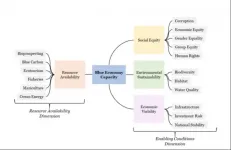Through two separate sets of experiments with this technique, the researchers discovered new genetic differences between humans and chimpanzees. They found a significant disparity in the expression of the gene SSTR2 - which modulates the activity of neurons in the cerebral cortex and has been linked, in humans, to certain neuropsychiatric diseases such as Alzheimer's dementia and schizophrenia - and the gene EVC2, which is related to facial shape. The results were published March 17 in Nature and Nature Genetics, respectively.
"It's important to study human evolution, not only to understand where we came from, but also why humans get so many diseases that aren't seen in other species," said Rachel Agoglia, a recent Stanford genetics graduate student who is lead author of the Nature paper.
The Nature paper details the new technique, which involves fusing human and chimpanzee skin cells that had been modified to act like stem cells - highly malleable cells that can be prodded to transform into a variety of other cell types (albeit not a full organism).
"These cells serve a very important specific purpose in this type of study by allowing us to precisely compare human and chimpanzee genes and their activities side-by-side," said Hunter Fraser, associate professor of biology at Stanford's School of Humanities and Sciences. Fraser is senior author of the Nature Genetics paper and co-senior author of the Nature paper with Sergiu Pa?ca, associate professor of psychiatry and behavioral sciences in the Stanford School of Medicine.
Close comparisons The Fraser lab is particularly interested in how the genetics of humans and other primates compare at the level of cis-regulatory elements, which affect the expression of nearby genes (located on the same DNA molecule, or chromosome). The alternative - called trans-regulatory factors - can regulate the expression of distant genes on other chromosomes elsewhere in the genome. Due to their broad effects, trans-regulatory factors (such as proteins) are less likely to differ among closely related species than cis-regulatory elements.
But even when scientists have access to similar cells from humans and chimpanzees, there is a risk of confounding factors. For example, differences in the timing of development between species is a significant hurdle in studying brain development, explained Pa?ca. This is because human brains and chimpanzee brains develop at very different rates and there is no exact way to directly compare them. By housing human and chimpanzee DNA within the same cellular nucleus, scientists can exclude most confounding factors.
For the initial experiments using these cells, Agoglia coaxed the cells into forming so-called cortical spheroids or organoids - a bundle of brain cells that closely mimics a developing mammalian cerebral cortex. The Pa?ca lab has been at the forefront of developing brain organoids and assembloids for the purpose of researching how the human brain is assembled and how this process goes awry in disease.
"The human brain is essentially inaccessible at the molecular and cellular level for most of its development, so we introduced cortical spheroids to help us gain access to these important processes," said Pa?ca, who is also the Bonnie Uytengsu and Family Director of Stanford Brain Organogenesis.
As the 3D clusters of brain cells develop and mature in a dish, their genetic activity mimics what happens in early neurodevelopment in each species. Because the human and chimpanzee DNA are bound together in the same cellular environment, they are exposed to the same conditions and mature in parallel. Therefore, any observed differences in the genetic activity of the two can reasonably be attributed to actual genetic differences between our two species.
Through studying brain organoids derived from the fused cells that were grown for 200 days, the researchers found thousands of genes that showed cis-regulatory differences between species. They decided to further investigate one of these genes - SSTR2 - which was more strongly expressed in human neurons and functions as a receptor for a neurotransmitter called somatostatin. In subsequent comparisons between human and chimpanzee cells, the researchers confirmed this elevated protein expression of SSTR2 in human cortical cells. Further, when the researchers exposed the chimpanzee cells and human cells to a small molecule drug that binds to SSTR2, they found that human neurons responded much more to the drug than the chimpanzee cells.
This suggests a way by which the activity of human neurons in cortical circuits can be modified by neurotransmitters. Interestingly, this neuromodulatory activity may also be related to disease since SSTR2 has been shown to be involved in brain disease.
"Evolution of the primate brain may have involved adding sophisticated neuromodulatory features to neural circuits, which under certain conditions can be perturbed and increase susceptibility to neuropsychiatric disease," said Pa?ca.
Fraser said these results are essentially "a proof of concept that the activity we're seeing in these fused cells is actually relevant for cellular physiology."
Investigating extreme differences For the experiments published in Nature Genetics, the team coaxed their fused cells into cranial neural crest cells, which give rise to bones and cartilage in the skull and face, and determine facial appearance.
"We were interested in these types of cells because facial differences are considered some of the most extreme anatomical differences between humans and chimps - and these differences actually affect other aspects of our behavior and evolution, like feeding, our senses, brain expansion and speech," said David Gokhman, a postdoctoral scholar in the Fraser lab and lead author of the Nature Genetics paper. "Also, the most common congenital diseases in humans are related to facial structure."
In the fused cells, the researchers identified a gene expression pathway that is much more active in the chimpanzee genes of the cells than in the human genes - with one specific gene, called EVC2, appearing to be six times more active in chimpanzees. Existing research has shown that people who have inactive EVC2 genes have flatter faces than others, suggesting that this gene could explain why humans have flatter faces than other primates.
What's more, the researchers determined that 25 observable facial features associated with inactive EVC2 are noticeably different between humans and chimpanzees - and 23 of those are different in the direction the researchers would have predicted, given lower EVC2 activity in humans. In follow-up experiments, where the researchers reduced the activity of EVC2 in mice, the rodents, too, developed flatter faces.
Another tool in the toolbox This new experimental platform is not intended to replace existing cell comparison studies, but the researchers hope it will support many new findings about human evolution, and evolution in general.
"Human development and the human genome have been very well studied," said Fraser. "My lab is very interested in human evolution, but, because we can build on such a wealth of knowledge, this work can also reveal new insights into the process of evolution more broadly."
Looking forward, the Fraser lab is working on differentiating the fused cells into other cell types, such as muscle cells, other types of neurons, skin cells and cartilage to expand their studies of uniquely human traits. The Pa?ca lab, meanwhile, is interested in investigating genetic dissimilarities related to astrocytes - large, multi-functional cells in the central nervous system often overlooked by scientists in favor of the flashier neurons.
"While people often think about how neurons have evolved, we should not underestimate how astrocytes have changed during evolution. The size difference alone, between human astrocytes and astrocytes in other primates, is massive," said Pa?ca. "My mentor, the late Ben Barres, called astrocytes 'the basis of humanity' and we absolutely think he was onto something."
INFORMATION:
Additional Stanford co-authors for the Nature paper are former research assistant Danqiong Sun, postdoctoral scholar Fikri Birey, senior research scientist Se-Jin Yoon, postdoctoral scholar Yuki Miura and former research associate Karen Sabatini.
This work was funded by a Stanford Bio-X Interdisciplinary Initiatives Seed Grant, the National Institutes of Health, the Department of Defense, the Stanford Center for Computational, Evolutionary and Human Genomics, the Stanford Medicine's Dean's Fellowship, MCHRI, the American Epilepsy Society, the Stanford Wu Tsai Neurosciences Institute's Big Idea Grants on Brain Rejuvenation and Human Brain Organogenesis, the Kwan Research Fund, the New York Stem Cell Robertson Investigator Award, and the Chan Zuckerberg Ben Barres Investigator Award.
Additional Stanford co-authors for the Nature Genetics paper are graduate student Maia Kinnebrew; former undergraduate Wei Gordon; former technician Danqiong Sun; postdoctoral research fellows Vivek Bajpai and Sahin Naqvi; Dmitri Petrov, the Michelle and Kevin Douglas Professor in the School of Humanities and Sciences; Joanna Wysocka, the Lorry Lokey Professor and professor of developmental biology; and Rajat Rohatgi, associate professor of biochemistry and of medicine. Researchers from University of California, San Francisco; University of Michigan, Ann Arbor; Yerkes National Primate Research Center; Emory University School of Medicine; and University of Pennsylvania are also co-authors.
This work was funded by the Human Frontier, Rothschild and Zuckerman fellowships, and the National Institutes of Health.
Fraser is a member of Stanford Bio-X, the Maternal & Child Health Research Institute (MCHRI), and the Stanford Cancer Institute. Pa?ca is a member of Stanford Bio-X, MCHRI and the Wu Tsai Neurosciences Institute, and a faculty fellow of Stanford ChEM-H.




